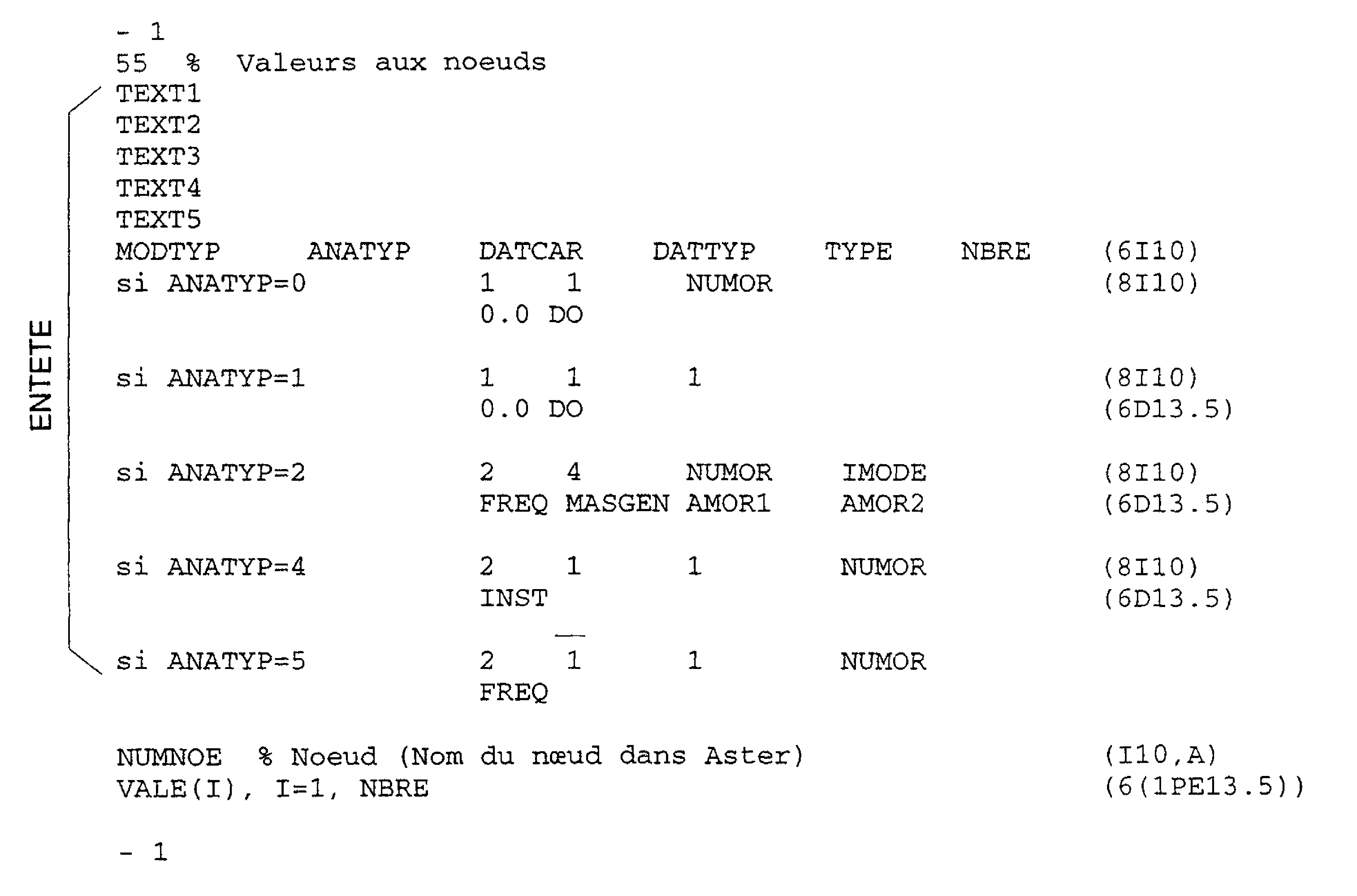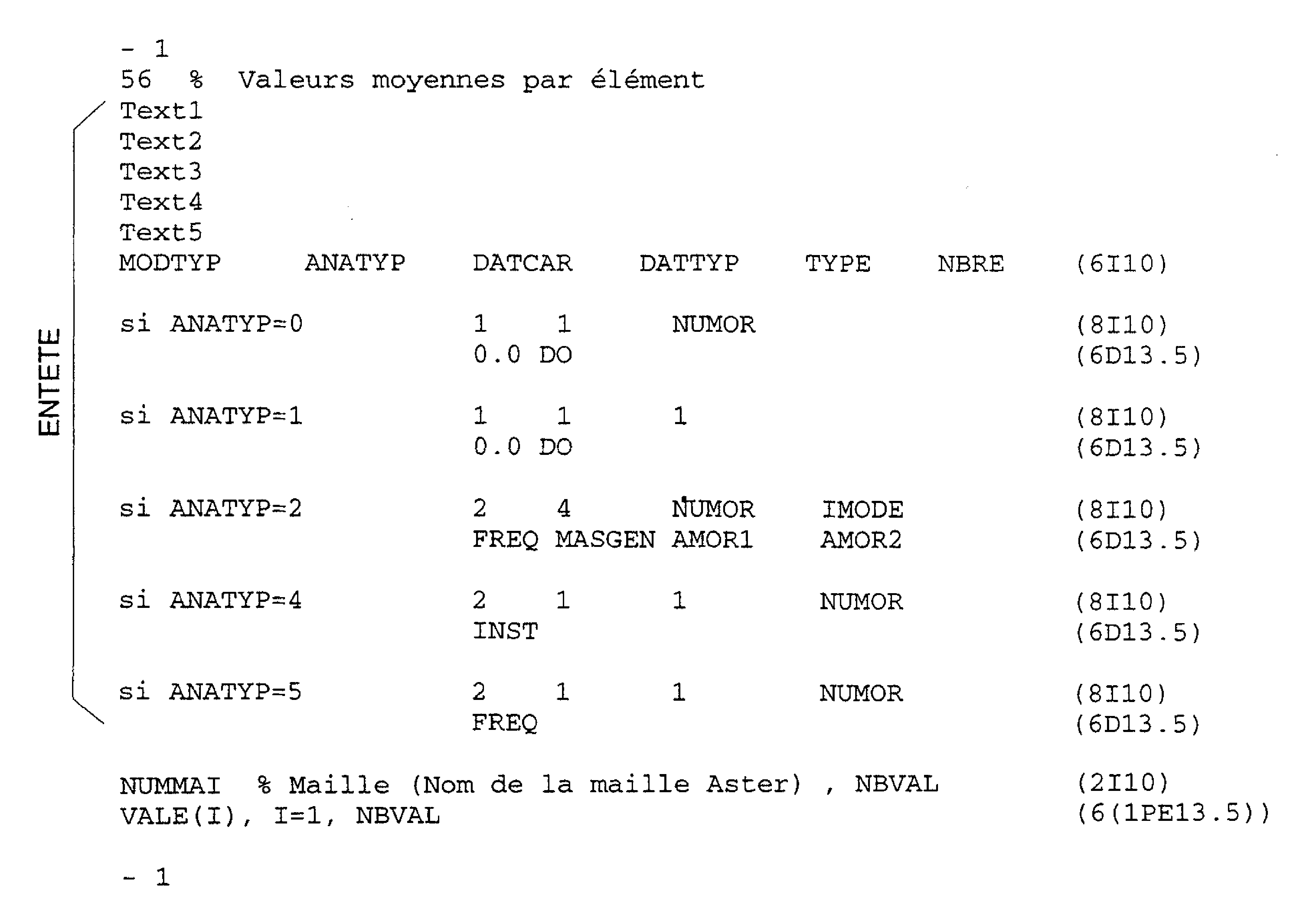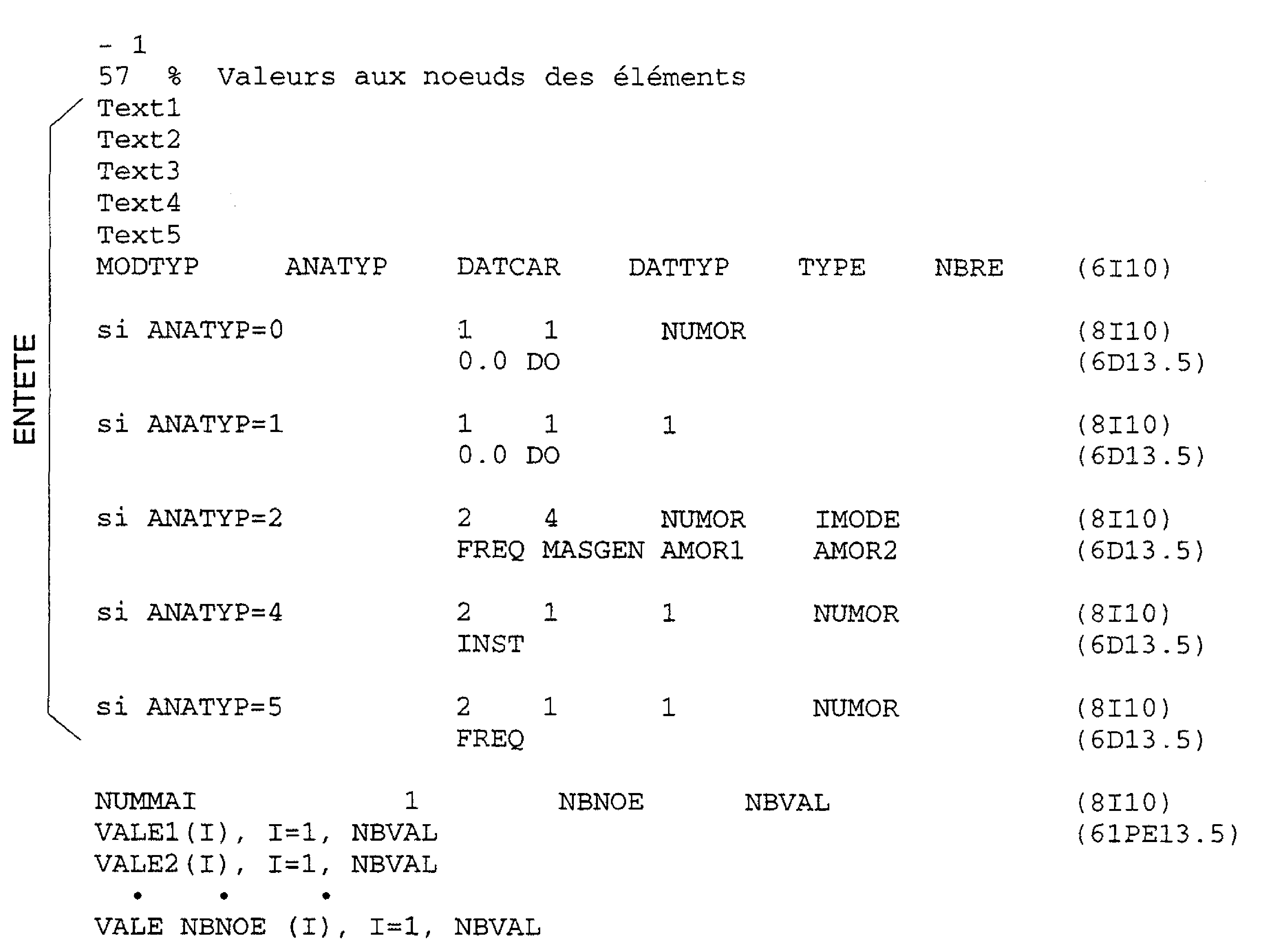2. Universal file structure IDEAS#
The overall structure of a universal file IDEAS is in the form of datasets characterized by their number.
Each dataset is surrounded by the « -1 » line:
Dataset no. - - - - 1 - 1 Dataset no. - - - - 1
Each dataset contains a particular type of information (node coordinates, mesh connectivity, node results,…), and is characterized by a specific number and computer structure.
However, dataset numbers and their computer structure are not fixed and may vary from version to version.
The IMPR_RESU command allows you to print meshes, and results at the nodes or by elements, at the user’s choice, in version 4 or 5 of IDEAS.
As a result, the number of datasets written by the IMPR_RESU command is reduced:
Version 4 |
Version 5 |
|
151 |
151 |
Title |
775 |
775 |
Properties of beams |
15 |
Node coordinates in simple precision |
|
781 |
Double precision node coordinates |
|
71 |
780 |
Mesh connectivity |
752 |
752 |
Knot and mesh groups |
55 |
55 |
Node results (cham_no) |
56 |
56 |
Element-wise results (cham_elem at Gauss point) |
57 |
57 |
Results at nodes by elements (cham_elem at nodes) |
2.1. Dataset 151: Title#
151% Title Aster Vxx.xx.xx of the date date result (A80) 1st line of the title Aster (A80) 2nd line of the title Aster (A80) white line (A80) 4th line of the title Aster (A80) 5th line of the title Aster (A80) 6th line of the title Aster (A80) - 1
This dataset is always the first dataset written to the universal IDEAS files generated by the IMPR_RESU command.
2.2. Dataset 775: Beam Properties#
This dataset is mandatory when the mesh includes beam-type elements, and is then just after the dataset151.
775% Properties: canister section, beams 1 0 0 (3I10) BEAM1 0. 0. 0. 0. 0. 0. 0. (6 (1 PE13 .6)) 0. 0. 0. 0. 0. (4 (1 PE13 .6)) 0. 0. 0. 0. 0. 0. 0. (6 (1 PE13 .6)) 0. 0. 0. 0. 0. 0. 0. » 0. 0. 0. 0. 0. 0. 0. » 0. 0. 0. 0. 0. 0. 0. » 0. 0. 0. 0. 0. 0. 0. » 0. 0. 0. 0. 0. 0. 0. » 0. 0. 0. 0. 0. 0. 0. » 11 7 8 14 1 10 (6I10) 0 45 1 11 1. (4I10,1 PE13 .6) - 1
2.3. Dataset 15: Node coordinates in simple precision#
If the user asks to write a mesh in the universal file format IDEAS version4, the coordinates of the nodes are written in simple precision, in the form of this dataset.
15% Knots n 0 0 11 X Y Z (4I10,3E13.6) • • • • • • • • • • • • • • - 1
\(n\): node number (it’s the Aster number unless the mesh was generated by IDEAS, in which case it’s the number IDEAS).
The following information concerns the definition of the coordinate system, which in Aster is always the Cartesian coordinate system, hence the value 0.
The fourth piece of information refers to the color that was affected when the node was displayed.
\(X\), \(Y\), \(Z\) are the three coordinates of the node.
Each node in the mesh corresponds to a row in the dataset15.
2.4. Dataset 781: Double Precision Node Coordinates#
If the user asks to write a mesh in the universal file format IDEAS version5, the coordinates of the nodes are written in double precision, in the form of this dataset.
781% Real Knots*8 n 0 10 11 (4I10) for each node X Y Z (3E25.17) • • • • • • • - 1
n: node number (it’s the Aster number unless the mesh was generated by IDEAS, in which case it’s the number IDEAS).
The following information concerns the definition of the coordinate system, which in Aster is always the Cartesian coordinate system, hence the value 0.
The fourth piece of information refers to the color that was affected when the node was displayed.
X, Y, Z are the three coordinates of the node.
Two rows in the dataset 781 correspond to each node of the mesh.
2.5. Dataset 71: Mesh Connectivities#
If the user requests that a mesh be written in the universal file format IDEAS version4, the mesh connectivities are written in the form of this dataset.
71% Elements IMAS ICOD1 ICOD2 IPHY IMAT 7 NNOE (7I10) NODSUP (J), J=1, NNOE (8I10) • • • • • • • - 1
The two lines of information shown are written for each element of the mesh.
IMAS: Knit number. It’s the Aster number unless the mesh was generated by IDEAS, in which case it’s the number IDEAS.
ICOD1: Graphic code of the element.
Graphic code |
Mesh |
Knots |
Type |
1 |
Linear |
2 |
Linear |
2 |
Triangle |
3 |
Linear |
3 |
Triangle |
6 |
Quadratic |
4 |
Triangle |
9 |
Cubic |
5 |
Quadrilateral |
4 |
Linear |
6 |
Quadrilateral |
8 |
Quadratic |
7 |
Quadrilateral |
12 |
Cubic |
14 |
Tetrahedron |
4 |
Linear |
15 |
Tetrahedron |
10 |
Quadratic |
16 |
Pentahedron |
6 |
Linear |
17 |
Pentahedron |
15 |
Quadratic |
18 |
Pentahedron |
24 |
Cubic |
19 |
Hexahedron |
8 |
Linear |
20 |
Hexahedron |
20 |
Quadratic |
21 |
Hexahedron |
32 |
Cubic |
ICOD2: Finite element descriptor
By default, a descriptor value is assigned to each mesh type. This is done when the user has not specified an Aster model and we therefore do not have the knowledge of the type of the finite element.
When the user has provided a model name, these default values are refined by default taking into account the type of the finite element. The elements concerned are:
MEAXQU4/THAXQU4 |
–> 84 |
(Axi linear quadrilateral) |
MEAXQU8/THAXQU8 |
–> 85 |
(Axi parabolic quadrilateral) |
MEAXTR3/THAXTR3 |
–> 81 |
(Axi linear triangle) |
MEAXTR6/THAXTR6 |
–> 82 |
(Axi parabolic triangle) |
MEDPQU4/THDPQU4 |
–> 54 |
(Plane strain linear quadrilateral) |
MEDPQU8/THDPQU8 |
–> 55 |
(Plane strain parabolic quadrilateral) |
MEDPTR3/THDPTR3 |
–> 51 |
(Plane strain linear triangle) |
MEDPTR6/THDPTR6 |
–> 52 |
(Plane strain parabolic triangle) |
MECPQU4/THCPQU4 |
–> 44 |
(Plane stress linear quadrilateral) |
MEPLQU4/THPLQU4 |
||
MECPQU8/THCPQU8 |
–> 45 |
(Quadrilateral parabolic plane stress) |
MEPLQU8/THPLQU8 |
||
MECPTR3/THCPTR3 |
–> 41 |
(Plane stress linear triangle) |
MEPLTR3/THPLTR3 |
||
MECPTR6/THCPTR6 |
–> 42 |
(Plane stress parabolic triangle) |
MEPLTR6/THPLTR6 |
||
MEAXSE2/MECPSE2 |
–> 21 |
(Linear beam) |
MEDPSE2/MEPLSE2 |
||
THAXSE2/THCPSE2 |
||
THDPSE2/THPLSE2 |
||
MEDKQU4/MEDSQU4 MEQ4QU4 |
–> 94 |
(thin shell: TN linear quadrilateral) |
MEDKTR3/MEDSTR3 |
–> 91 |
(thin shell: TN linear triangle) |
IPHY: physical properties table number= Aster number associated with the mesh type or Aster number associated with the finite element type if a model has been specified by the user.
IMAT: number of the material characteristics table = 1 except for meshes reduced to one point in which case IMAT is 2.
The following record shows the color of the item when displayed in IDEAS (by default 7 green color).
NNOE: number of nodes defining the mesh.
NODSUP (J), J=1, NNOE: list of the numbers of nodes making up the mesh.
Note:
Aster meshes that do not exist in IDEASsont ignored by the interface (QUAD9, HEXA27) .
2.6. Dataset 780: Mesh Connectivities#
If the user requests that a mesh be written in the universal file format IDEAS version5, the mesh connectivities are written in the form of this dataset.
780% Elements IMAS ICOD2 1 IPHY 1 IMAT 7 NNOE (8I10) NODSUP (J), J=1, NNOE (8I10)
% if line meshes
IMAS ICOD2 1 IPHY 1 IMAT 7 NNOE (8I10) 0 1 1 1 1 (5I10) NODSUP (J), J=1, NNOE (8I10) - 1
IMAS: mesh number. It’s the Aster number unless the mesh was generated by IDEAS, in which case it’s the number IDEAS.
ICOD2: finite element descriptor (see description dataset 71).
IPHY: number of the physical properties table (see description dataset 71).
IMAT: number of the material characteristics table (see description dataset 71).
The following record shows the color of the item when displayed in IDEAS (by default 7 green color).
NNOE: number of nodes defining the mesh.
Notes:
To write a beam element, we have an additional row in the 780 dataset. This line defines the characteristics of the beam, including the number of the node used to orient the main directions of the beam. The values written by the IMPR_RESU command are bogus values.
Aster meshes that do not exist in IDEASsont ignored (QUAD9, HEXA27) .
2.7. Dataset 752: Node and mesh groups#
752% Groups NUM 0 0 0 0 NBRE (6I10) NOM (20A2) (ICOD, MUMENT) I=1, NBRE (8I10) • • • • • • • • • - 1
For each group of nodes or Aster meshes, we write the instructions indicated above.
NUM: Group number. It’s sequential; we start with the groups of nodes in the order in which they appeared in*Aster*.
NBRE: Number of knots or meshes that make up the group.
NOM: Group name. It’s the name*Aster*.
ICOD: It is a code indicating the next type of entity. 7 indicates that the number that follows is that of a node, 8 indicates that the number that follows is that of a mesh.
NUMENT: Entity number (number of a node or a mesh).
Note:
The third line is repeated as many times as necessary to write all the node or mesh numbers that make up the group.
2.8. Writing results Aster: CHAM_GD or Concept RESULTAT#
The three datasets used to write Aster results are datasets55 (for fields at nodes), 56 (for fields by elements at Gauss points) and 57 (for fields by elements at nodes) and 57 (for fields by elements at nodes).
2.8.1. Dataset 55: Node values#

MODTYP: model type |
MODTYP = 1Structural |
MODTYP = 2Heat transfer |
The IMPR_RESU command takes MODTYP =1 except when the quantity associated with the field to be printed is TEMP or FLUX, in which case MODTYP =2.
ANATYP: type of analysis
ANATYP |
=0 |
|
Value taken by default by command IMPR_RESU |
=1 |
|
Value taken when printing quantity fields named in Aster |
|
=2 |
|
Value taken when printing a result concept with access variable NUME_MODE |
|
=4 |
|
Value taken when printing a result concept with access variable INST |
|
=5 |
|
Value taken when printing a result concept whose access variable is FREQ and not NUME_MODE |
DATCAR = data characteristic
=1 |
scalar |
=3 |
vector with 6 degrees of freedom (3 translations and 3 rotations) |
=4 |
symmetric tensor |
DATTYP = data type
=0 |
unknown |
=2 |
constraints |
=3 |
deformations |
=5 |
temperature |
=6 |
flow |
=8 |
displacement |
=11 |
speed |
=12 |
acceleration |
=15 |
pressure |
TYPE = 2 for real values, 5 for complex values.
NBRE = number of values to be printed per node.
NUMOR = Aster order number for result concepts.
IMODE = value of the access variable NUME_MODE for the order number in question (for result concepts having this access variable).
FREQ = value of the access variable FREQ for the order number in question (for result concepts with the access variable FREQ).
MASGEN = value of the parameter MASSE_GENE for the order number in question (for result concepts with an access variable of NUME_MODE).
AMOR1 = value of the parameter AMOR_REDUIT for the order number in question (for result concepts with an access variable of NUME_MODE).
AMOR2 = 0.D0
INST = value of the access variable INST for the order number in question (for result concepts with the access variable INST).
NBRE = number of result values per node.
NUMNOE = node number.
VALE = result values (cham_no) at the node in question.
2.8.2. Dataset 56: Values by elements#

The header of this dataset is identical to that of dataset 55.
NUMMAI = stitch number.
NBVAL = number of values on the mesh.
VALE = values of the result (cham_elem at Gauss points) on the mesh in question. Cham_elem at Gauss points*Aster* are written in IDEAS format as constant fields per element (average of values at Gauss points).
2.8.3. Dataset 57: Node values by element#

The header of this dataset is identical to that of datasets 55 and 56.
NUMMAI = stitch number.
NBNOE = number of knots in the mesh.
NBVAL = number of values per node.
VALEJ = values of the result (cham_elem at the nodes) on node \(J\) of the mesh in question.
2.9. Rule for writing a result dataset#
In Code_Aster, quantity fields are fields at nodes or fields per element at Gauss points or at nodes.
Fields at nodes are written as datasets number55, fields by elements at Gauss points as datasets number56, and fields by element at nodes as datasets 57.
For result concepts, we treat order number by order number and symbolic name by symbolic name, the various quantity fields composing the result concept.
The only difference in writing datasets 55, 56 and 57 is the value of the code corresponding to the type of analysis (ANATYP) which is 1 for the quantity fields named in Aster, and 2, 4, or 5 for the result concepts (see description dataset 55).
In Code_Aster, a quantity field is associated with a quantity whose list of possible components is defined in a catalog. The various components can be vectors, tensors, or scalars.
In IDEAS, a dataset has a maximum of 6 components, and these components are typed:
vectors with 6 components such as displacement, speed, acceleration, flow or unknown,
symmetric tensors such as stresses or deformations,
temperature or pressure scalars.
Also, an Aster quantity is associated with a finite number of IDEAS datasets that can be written (if the components really exist on the model). The IRGAGS .f routine does this work.
For example, consider the quantity DEPL_R whose components are DX, DY, DZ, DRX, DRY, DRZ, GRX, DDZDN, PRES, PHI.
A node field associated with this quantity corresponds to a maximum of three IDEAS datasets (all three of number55):
a 6-component vector dataset for writing DX, DY,… DRZ,
a scalar dataset for writing PRES,
a dataset of unknown type for writing components GRX, DDZDN, PHI.
These datasets may then exist or not depending on the presence or absence of the components. The dataset exists as soon as one of its constituent components is defined on a mesh node (in which case the value of the missing components is 0.).
With regard to the internal variables, one or more (a dataset includes a maximum of 6 components) datasets of number 55 and of the type « UNKNOWN » are generated.